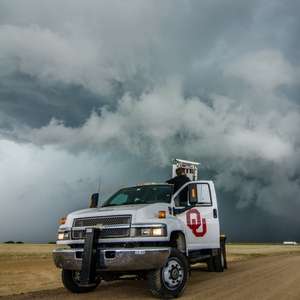NORMAN—The University of Oklahoma’s newest Shared Mobile Atmospheric Research and Teaching Radar, SR3, today deployed to Monroe, Louisiana, where a slight risk of tornadic storms exists. An upgrade of the original dual-polarimetric SMART radar, the SR3 just completed its first mission on March 19 to New Market, Alabama, in coordination with the National Oceanic and Atmospheric Administration’s National Severe Storms Laboratory.
“The SR3 and NOAA’s P-3 aircraft collected data on a rapidly evolving severe hailstorm that preceded a series of tornadic supercells. The SR3 collaborated with the University of Alabama Huntsville and National Weather Service Hytop radars in southern Tennessee on sampling a tornadic storm that produced significant damage as it crossed the border into northern Alabama. Multi-radar observations were captured over a three-hour period from the initial organization to tornadic dissipation,” said Michael Biggerstaff, professor of meteorology and director of the OU SMART radar program.
The SR3 observed a second tornadic storm to the south that produced five tornadoes and hailstones as large as 5.25 inches. The P-3 aircraft flew ahead of the southern tornadic storm and measured winds within the storm during all five tornadoes. The SR3 and P-3 aircraft will continue to work together near Monroe tonight. The project is part of the Southeastern Tornadogenesis and Risk Reduction Exercise, which runs until April 13. The STARR project is part of the larger VORTEX-Southeast research project funded by NOAA. https://www.nssl.noaa.gov/projects/vortexse/
When the project ends, the SR3 will return to Oklahoma to be used to train the next generation of scientists in an undergraduate radar meteorology course. For more information about the SR3, contact Biggerstaff at 405-623-1769. For information about VORTEX-SE, contact keli.pirtle@noaa.gov.



